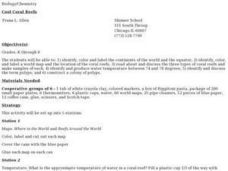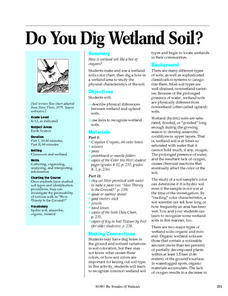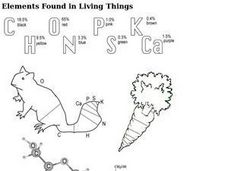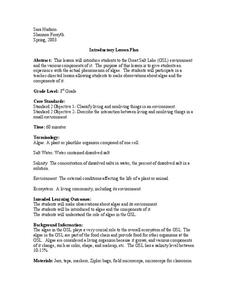Curated OER
How much Carbon Dioxide is in My Seltzer Water?
Students discover the law of conservation of mass though experimentation. In this chemistry lesson, students experiment with acid - base indicators to determine the presence of carbon dioxide. Students complete the labs with analysis...
Curated OER
Biocomplexity Lab Activity: Measuring Water pH
Students test unknown solutions for pH levels to determine which organism can live in each environment. They name three substances that they think are acids. Students determine a solution is an acid or base. They define the term pH.
Curated OER
Mixing Colors
Students listen to a story about mixing colors. They explore color using cups of water, color and coffee filters. They use sight word vocabulary to describe the colors.
Curated OER
Cool Coral Reefs
Students identify, color and label the continents of the world and the equator. They identify and produce water temperature between 74 and 78 degrees. They identify and discuss the term polyps and construct a colony of polyps.
Curated OER
Mimeograph Madness
Students practice working with a mimeograph. After having a sketch approved, they trace their drawing and color all areas they do not want a certain color. They complete their creation by placing the sketch on newspaper after it has...
Curated OER
Do You Dig Wetland Soil?
Students study the physical differences between wetland and upland soils. They match colors to the different levels of the soil after digging holes. They create soil color charts and chart the texture of the soils.
Curated OER
Polar Bear Polar Bear
Students explore fictional literature. Students listen to a story about a polar bear who changes color. Students observe color models of the bear as the teacher reads. Students perform hand motions to parts of the story. They...
Curated OER
Oregon Rainshadows
Students brainstorm list of possible highest locations in Oregon, identify and label places from list on map using color code, and discuss and identify causes of a rain shadow.
Curated OER
Acid Rain
Students write paragraphs and color illustrations about acid rain. They color in where gases come from, where they mix, and where they return. They discuss where acids form in the atmosphere and list manmade sources of gases.
Curated OER
New Jersey Estuaries
Students experiment to discover that salt water is denser than fresh water by creating color coded solutions. They examine how heavy rainstorms and high tides develop layers of different degrees of density.
Curated OER
Design Motifs and Eggs
Students create an Easter egg that displays at least one secondary color, one primary color, and one motif of design.
Curated OER
Vegetable Lab
Third graders prepare vegetables using common methods: au gratin, minimum water method, broiled, panfry, frozen, and stuffed. They share with the rest of the class and determine which methods preserve nutrients, color, flavor and texture.
Curated OER
Plant Activities: To Dye For
Students use natural plant dyes to color their clothing as they did in the past.
Curated OER
Am I Neutral? pH Properties in Soil
Students participate in a science lab to determine the pH of three different soil samples. Students conduct an experiment by creating a question, a hypothesis and then an investigation of soil samples. Then they compare colors apprearing...
Curated OER
Oolitic Sand: An Introduction
Fourth graders investigate the characteristics of different types of sand. They compare and contrast the types of sand by making observations with a dissecting microscope. Then students draw what is seen and include shape, color, and...
Curated OER
Elements Found in Living Things
In this elements worksheet, students review the most common elements found in living things. Students color in two pictures with the percentages of the elements found in that living thing.
Curated OER
Backwards Watercolors
Students create a watercolor picture. In this watercolor lesson, students cover the entire page with water. They color with a marker on top of the water and watch as the colors run and blend together.
Curated OER
Rain and Our Environment
First graders understand the importance of rain in our environment by writing a sentence about something in existence that would cease to be without rain. They use describing words to describe the living thing's color and draw and color...
Curated OER
Pokemon Tag
Students play a tag variation game. Four different colored hula hoops are placed in the corners of the gym with a ball of the same color. Four students are selected to be the Pokemon taggers, they stand in their corresponding hula hoop....
Curated OER
Frozen Film
Students are introduced to the topic of light interference through this hands-on activity. They observe how light reflects off two surfaces and then meets to form an interesting variation of color on a film surface.
Curated OER
Separation of Unknowns in a Liquid
Learners identify chromatography as method of separating the components of a liquid. Students discover that dyes are composed of more than one component in achieving a particular color in these lessons on paper chromatography.
Curated OER
Coal Formation
Students create a condition in an aquarium which allows the formation of coal. Students observe changes in decomposition and color of materials present in aquarium before a coal layer appears. Plant "fossil" imprints will be left behind.
Curated OER
Great Salt Lake
Third graders are introduced to the Great Salt Lake (GSL) environment and the various components of it. They make observations about algae and its environment and discuss why it is considered a living organism and various components of...
Curated OER
From Caterpillar to Butterfly
Students read and discuss the book about the butterfly and create their own butterflies using liquid watercolors and pipe cleaners. They then create a butterfly development book, included in the instructional activity, and color the...

























